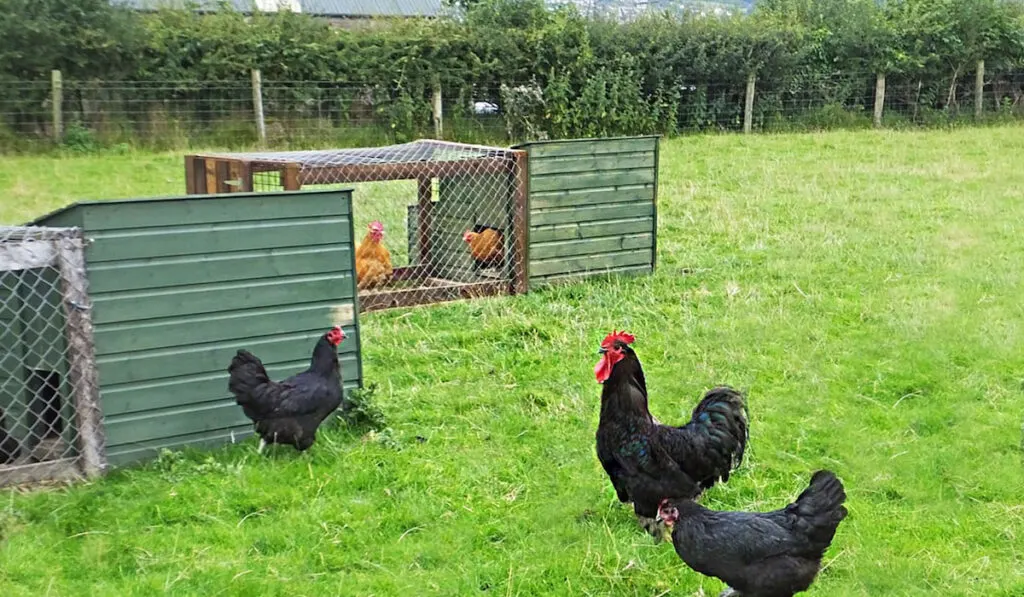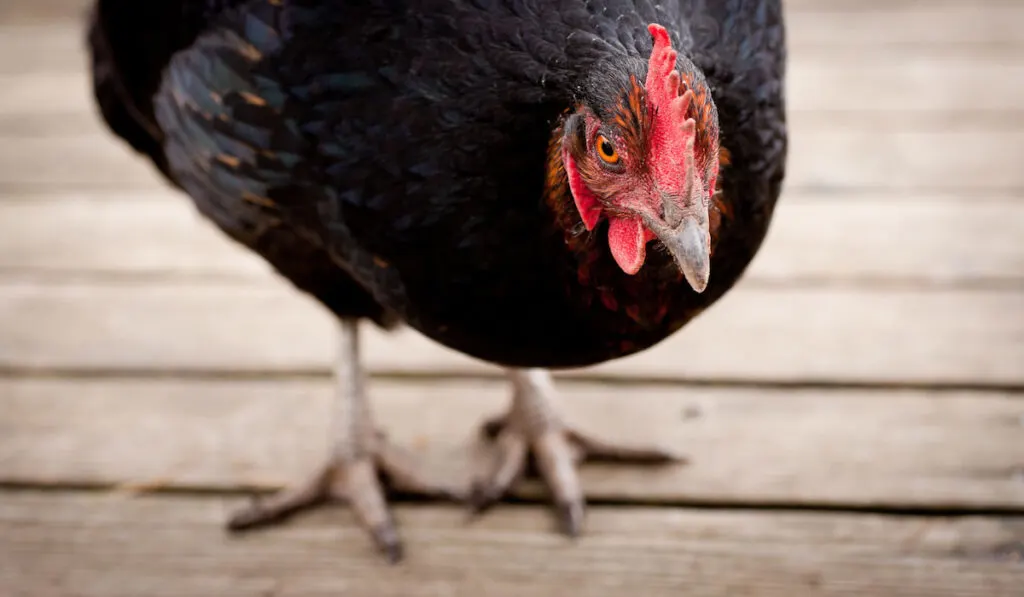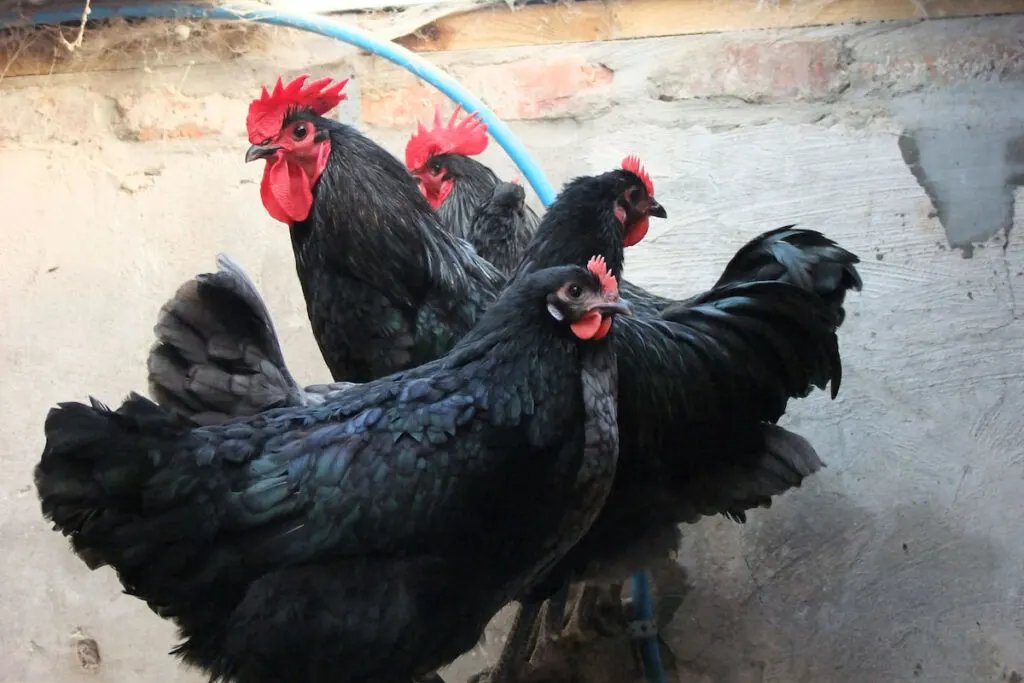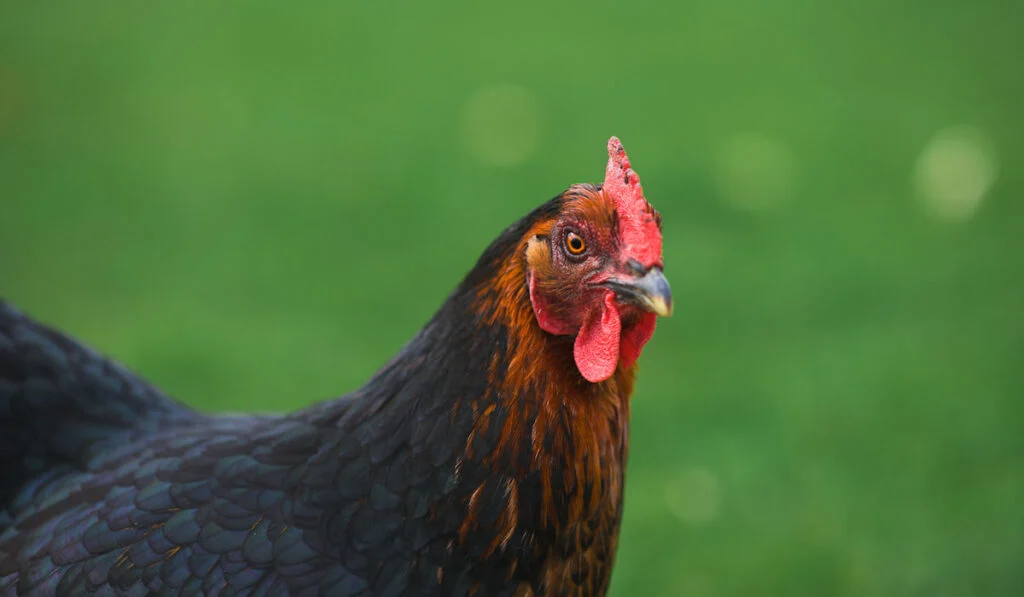The Jersey Giant chicken is America’s largest purebred chicken.
The Jersey Giant chicken can weigh up to 15 pounds (6.8 kilograms), which makes them one of the largest chicken breeds in the world.
While they are typically used as meat birds, Jersey Giant chickens can also make great pets.
The Jersey Giant dates back to the 19th century and is renowned for its size, intelligence, and docile nature.
In this blog post, we will explore the characteristics of this amazing chicken breed in depth.
From temperament to color variations to egg production, read on to learn everything you need to know about the Jersey Giant.

Table of Contents
History of the Jersey Giant Chicken
The Jersey Giant breed is a heritage breed native to the United States.
They were originally bred in New Jersey in the late 1800s by Thomas and John Black and were meant to be a replacement for turkeys- a large breed of chicken that was large enough to be used as a meat bird but also had good egg-laying abilities.
Thomas and John Black crossed existing chicken breeds— the Dark Brahma, the Black Java, and the Black Langshan— which then resulted in the Jersey Giant chicken breed.
The breed was quickly accepted and dubbed “Black Giant,” after the Black brothers and not necessarily after their color.
The Black Giant quickly became popular with farmers and homesteaders due to its size and utility.
It was eventually discovered to be a slow grower, requiring more time and feed to reach its full size than other birds. This slow growth led to most farmers not keeping the Jersey Giant for meat past the 1800s.
However, as the breed neared extinction, efforts were made by some farmers to preserve it. Those efforts helped the Jersey Giants become popular once more.
The American Livestock Breeds Conservancy has since moved it from the Endangered List to the Watch category of the Conservation Priority List.
From the 1800s to date, only three variants of the Jersey Giant have been recognized to have met the Standard of Perfection set by The American Poultry Association (APA) for the Jersey Giant breed.
This includes the Black Jersey Giant, accepted in 1922; the White Jersey Giant, accepted in 1947; and the Blue Jersey Giant, accepted in 2003.
The Splash variant is yet to be accepted, and there are talks of new silver and barred variants.
The black Jersey Giant is the most common variant, with its all-black plumage and a greenish metallic sheen.
Ironically, the Jersey Giant chicken also has a bantam variant.

Description
The Jersey Giant chicken is America’s largest dual-purpose chicken breed. This breed is larger than the average turkey, and the only breed closely associated in size with the Jersey Giant is the Dark Brahma.
Jersey Giants have a brick-shaped build with a long deep chest. They also have a single red comb, red wattles, and earlobes.
They have four toes, like most birds, and tight feathers, which contribute to their tolerance to cold climates.
The black Jersey Giant has a characteristic black plumage with beetle-green iridescence on its feathers.
Males often weigh 13-15 lbs. and can grow to a height of 26 inches, while females weigh an average of 11bs and grow to a height of 16-20 inches.
Black Jersey Giants are yellow-skinned birds. They have black legs with yellow soles, a major differentiating factor between Jersey Giants and black Australorps.
Their eyes are a dark shade of brown, and they have yellow-tinged black beaks. The typical black Jersey Giant chick appears black with a tinge of cream on its underbelly, around its face, and on the tips of the wings.
White Jersey Giants have white feathers, willow-colored shanks, and yellow soles. They also have a yellow hue on their beaks.
White Jersey Giant chicks are mostly gray in appearance, and their colors range from almost black to light gray.
The Blue Jersey Giant has slate blue feathers laced with a darker shade of blue. Their shanks are black with yellow soles.
Blue Giant chicks are white with light blue coloring.
Characteristics of the Jersey Giant Chicken
| Breed Name | Jersey Giant |
| Colors | Black, white, and blue |
| Temperament | Friendly, calm, and docile |
| Tolerance | Cold-hardy, heat-tolerant |
| Purpose | Dual purpose, i.e., meat and egg |
| Weight | 11-15 lbs. |
| Productivity | Average |
| Egg size | Large |
| Egg color | Light to medium brown |
| Feathered legs | No |
| Comb | Single, red |
| Broodiness | medium |
| Breed classification | Large |
The Jersey Giant chicken is an excellent choice for meat production, as they have a high yield of meat on their bodies.
Jersey Giants are also good layers and can produce up to 200 eggs annually, even in cold climates. The eggs are large and brown.
They are slow growers and take longer to reach their full size, unlike other birds. This also means that they require more food, unlike other birds.
Jersey Giant hens begin laying at approximately 24 weeks old.
Behavior/Temperament

Jersey Giants are a friendly breed of chicken and make good pets. They are docile and not known to be aggressive.
Although they handle confinement well, they do require a larger space. The ideal spacing for a Jersey Giant is 8 square feet per bird, and at the lowest, 4 square feet per bird.
Jersey Giants are well-known foragers and can find food in even the most overgrown areas. Jersey Giants are cold-hardy and can withstand colder temperatures than many other breeds of chicken.
The Jersey Giant chicken is an excellent choice for a large bird that is friendly, productive, and cold hardy.
Broodiness, Incubation, and Brooding
Jersey Giant hens can also go broody like other hens. However, their success rate is less than optimal because they often break the eggs they sit on due to their enormous size.
Breeders interested in hatching their Jersey Giant eggs are advised to cushion the floors of the nest boxes to prevent the eggs from breaking or use an incubator.
It is important to note that Jersey Giant chicks take a day or two longer than other birds to hatch.
Jersey Giant chicks are usually bigger than other chicks, even as hatchlings, and would require more brooding space.
They also feather slower than other birds and would normally stay longer in brooding houses.
For optimal growth, ensure that the chicks are fed the right ration (chicks mash); the brooding house has good bedding and is warm enough for the chicks to thrive.
The temperature in the brooding house can be monitored and regulated using a brooding/incubation thermometer, as the temperature must stay within the range appropriate for the age of the chicks.

How to Care for Jersey Giant Chickens
The Jersey Giant chicken is a large bird weighing up to 13 pounds. They are a hardy breed good for both meat and eggs.
Here are some tips on how to care for your Jersey Giant chickens:
1. Provide plenty of space
Jersey Giants are a large breed, so they need plenty of space to roam. A good rule of thumb is to provide at least 8 square feet of space per chicken.
2. Keep the coop clean
Clearing, cleaning, and regularly disinfecting the coop will help keep disease-causing organisms to a minimum and keep your chickens healthy.
Be sure to regularly remove old bedding, food, or water and replace it with fresh items.
3. Provide a balanced diet
A healthy diet is vital for all chickens, especially for larger breeds like the Jersey Giant.
Be sure to provide a mix of grains, vegetables, and proteins in their diet. You can also offer occasional protein-packed treats like insects/bugs if you’re raising the chickens for meat.
4. Give them access to fresh water at all times
Water is essential for chickens, so be sure they have access to a clean and fresh water source at all times.
You can serve them water in a simple water trough or a larger water dispenser if you have multiple chickens.
Be sure to keep the water troughs off the floors to prevent contamination with poop or bedding materials.
5. Check for predators regularly
Even though the Jersey Giant chicken can sometimes take their stand against predators, predators can still be a big threat to them.
Regularly checking around your coop and property for signs of predators is important. If you find any evidence of predators, take steps to deter them from coming.

What Do Jersey Giant Chickens Eat?
Jersey Giants are famous for their large size. This enormous size also means they eat more than most birds. But what do these big birds eat?
The ideal feed for the Jersey Giant chicken is nutritionally dense, such as a growers’ mash, which is around 19% protein and easily digestible.
The Jersey Giant chicken consumes an average of 5.5 oz of feed per day.
Feed your Jersey Giant chicks with either starter mash or growers mash for up to 6 weeks old. Afterward, chicken feed pellets with about 16% protein are adequate.
As they grow, they need more food and more nutrition to keep up their growth and weight.
Proper feeding is also essential if you want them to reach the desired weight or start laying eggs at the right time.
A healthy diet for a Jersey Giant chicken includes
- Whole grains
- A moderate amount of protein
- Some calcium in the form of crushed oyster shells or eggshells
- A small amount of fiber to help with digestion
- A variety of fresh fruits and vegetables
- Plenty of leafy greens
The free-range system is the best way to raise the Jersey Giant chicken. This is because in addition to the mash they are fed, they will be able to pick up protein sources like insects, bugs, leafy greens, etc.
Of course, you’ll want to consult with your veterinarian to ensure you meet your chicken’s nutritional needs.

Size of Jersey Giants
The average weight of the different growth stages of the Jersey Giant Chicken is as follows:
- Hens: 11 lbs.
- Cocks: 13 lbs.
- Cockerels: 11 lbs.
- Pullets: 8 lbs.
- Capons: 20 lbs.
Lifespan
The Jersey Giant has an average lifespan of eight years.
Housing
Jersey Giants are large birds and, as such, require more room than the average bird. They are also tall and require specific sizing for their coops.
Each Giant requires about 8 square feet of space, and the ceiling of the coop should be at least 2 feet above their heads.
Also, they might be prone to leg/foot injury from landing because they are large. Hence, perches should be set closer to the ground to reduce the risk of injuries.
Their nesting boxes should be placed one foot from the ground and should be at least 18 by 18 inches in length and width.
Egg Production of Jersey Giant Chickens
While they are not as popular as they once were, Jersey Giants are still a desirable choice for egg production.
They are good layers of brown eggs, with each hen capable of laying 150-200 eggs per year, approximately 4-5 eggs per week.

Pros and Cons of Keeping Jersey Giant Chickens
While Jersey Giants are good for eggs and meat and make great backyard chickens, there are also downsides to keeping them.
Here are the pros and cons of keeping this large breed of chicken:
Pros:
- Jersey Giants are very friendly chickens. They love people and will often follow their owners around the yard.
- They’re great for both eggs and meat. Jersey Giants are a good choice if you want to get the most out of your chickens.
- They’re relatively low maintenance compared to other chicken breeds. Jersey Giants don’t need a lot of special care or attention.
Cons:
- They are slow growers and take longer to reach full size than other birds.
- Their large size also means that they require more food than other chicken breeds. You’ll need to ensure you have enough space (and food) to accommodate their appetite.
Summary
The Jersey Giant is one of the most impressive chicken breeds, with good reason. It’s a dual-purpose bird — a good egg layer and an excellent meat producer due to its large size.
Despite this size, the Jersey Giant Chicken is gentle and friendly with people, making it an excellent choice for egg farmers and homesteaders.
These gentle giants tick the boxes for what the ideal chicken should be, and it’s no wonder they have gained such popularity.
Resources
- https://www.thefeatherbrain.com/blog/jersey-giant-chickens
- https://cs-tf.com/jersey-giant-chicken
- https://livestockconservancy.org/heritage-breeds/heritage-breeds-list/jersey-giant-chicken
- https://www.roysfarm.com/jersey-giant-chicken
- https://www.ecopeanut.com/jersey-giant-chicken-breed-guide
- https://breeds.okstate.edu/poultry/chickens/jersey-giant-chickens.html
- https://www.thehappychickencoop.com/jersey-giant
- https://www.chickensandmore.com/jersey-giant
- https://chickencondos.com/brooder-incubation-thermometer.html
- https://www.poultrypages.com/jersey-giant-chickens
- https://delaneychicken.com/jersey-giant-chicken
- https://www.knowyourchickens.com/jersey-giant-chicken
- https://www.backyardchickens.com/articles/jersey-giants-chicken-breed-information.47788
- https://thriftyhomesteader.com/jersey-giants
- https://chickencondos.com/brooder-incubation-thermometer.html
- https://homesteadontherange.com/2022/04/05/jersey-giant
- https://poultryparade.com/all-you-need-to-know-about-jersey-giants/
